

SPRING 2023 PLANT.CA CLEAN TECHNOLOGY Why it should be a priority. p.16 SAFETY Signs of eye discomfort. p.14 WORK CULTURE Putting customer’s needs first. p.19 Q&A Honda retools Ontario plant. p.10
SPRING 2023
10
HONDA’S JOURNEY TO RETOOL ALLISTON PLANT
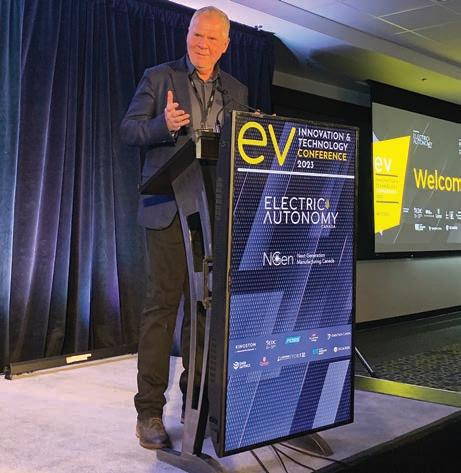
Plant spoke with Jeff Hansen at Honda of Canada Mfg. about Canada becoming the lead plant for Honda’s CR-V Hybrid.
12
14
VALUE STREAM MAPPING

Leverage your value stream mapping exercises to become more environmentally friendly.


LOOK OUT FOR SIGNS OF EYE DISCOMFORT
When people think of eye-related hazards in the manufacturing ind ustry, what typically come to mind are dust, chemicals, and flying objects.
16
OPPORTUNITIES IN CLEAN TECHNOLOGY
Plant spoke with Dennis Dussin at Alps Welding Ltd. about the use of clean technologies in the manufacturing space.
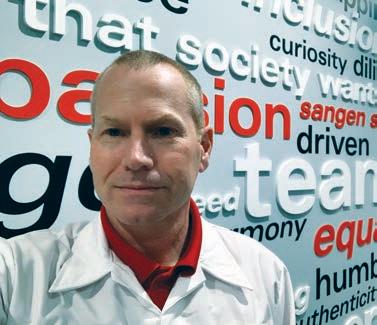
19
WHY YOU NEED A CUSTOMER-CENTRIC CULTURE
Cleantech is a relatively new sector that is experiencing significant growth.
Cover Photo: PavloBaliukh / iStock / Getty images
story
Cover
16 INSIDE 8 10
19 In every issue 4 EDITORIAL 6 NEWS 8 EVENTS EV future takes centre stage. 20 TECH CENTRE 22 POSTSCRIPT We need to turn tech leadership into real value for manufacturers @PLANT_Magazine Spring 2023 / Plant 3
12
Will 2023 be a better year than 2022?
SPRING 2023 • Volume 81, Number 1
READER SERVICE
Print and digital subscription inquiries or changes, please contact customer service
Angelita Potal
Tel: (416) 510-5113
Fax: (416) 510-6875
email: apotal@annexbusinessmedia.com

Mail: 111 Gordon Baker Rd., Suite 400 Toronto, ON M2H 3R1

EDITOR Mario Cywinski 226-931-4194 · mcywinski@annexbusinessmedia.com
SENIOR PUBLISHER Scott Atkinson 416-510-5207 · satkinson@ annexbusinessmedia.com
NATIONAL ACCOUNT MANAGER Ilana Fawcett 416-829-1221 · ifawcett@annexbusinessmedia.com
MEDIA DESIGNER Graham Jeffrey
ACCOUNT COORDINATOR Debbie Smith 416-442-5600 ext 3221 · dsmith@annexbusinessmedia.com
AUDIENCE DEVELOPMENT MANAGER Beata Olechnowicz 416-510-5182 · bolechnowicz@annexbusinessmedia.com
GROUP PUBLISHER Paul Grossinger pgrossinger@annexbusinessmedia.com
Earlier this year, we conducted an online poll in which we asked our readers: “How do you foresee 2023 shaping out for your company?” It is great to see that the results show positivity, as 46 per cent of respondents believe it will be better than 2022. Almost a quarter (24 per cent) believe that 2023, will be the same as 2022 for their company. What is slightly worrying is that 29 per cent believe that 2023 will be worse than 2022.

Plant, increasing paper prices necessitated a move that would allow us to continue to provide the superior content that our readers have come to expect without the added costs of printing and distribution.
You may have noticed we’ve changed our tagline to Canada’s Manufacturing Voice, as we aren’t simply a magazine anymore, but the voice of manufacturing in Canada.


PRESIDENT/COO Scott Jamieson sjamieson@annexbusinessmedia.com

ANNEX BUSINESS MEDIA
111 Gordon Baker Road, Suite 400
Toronto, ON M2H 3R1
Tel (416) 442-5600 · Fax (416) 510-5134 www.annexweb.com
SUBSCRIPTION RATES
With the COVID-19 pandemic mostly in the rear-view mirror, changes are happening everywhere, some companies are going back to pre-pandemic way of doing business, some are continuing to work the way they have during the pandemic, and others have now taken on a hybrid approach.
At Plant, we are also changing, as this publication will move to become a more digital/ online based publication in 2023. As a result, we will have only two print issues in 2023, as well as any special issues or surveys that are of utmost importance.
These decisions did not come lightly, almost every industry has had to face changes. Standing still is no longer an option. For
Moving forward, you will see Plant cover more topics online, with a greater focus on in-depth features that go to the root of issues affecting manufacturing in Canada. In this issue of Plant, we have two question and answer features, this will be something that we will do more of; speak to those in the industry and get their perspectives and expertise. This may also take the form of roundtables, podcast interviews, videos, and more. Doing these types of features online will allow us to be more current with content of interest to manufacturing professionals.
With a greater focus on digital, we will be posting more content to Plant.ca, with more visual content by way of videos on the web site and our YouTube channel.
Going back to the original poll, by way of Plant aiming to have a better 2023 than 2022, we want to help our readers do the same. If you have any suggestions on what content you would like to see in Plant, don’t hesitate to e-mail me.
MARIO CYWINSKI, EDITOR Comments? E-mail mcywinski@plant.ca
Canada – $76.00 per year
USA – $201.00 (CAD) per year
International – $227.00 (CAD) per year
Single copy – Canada $12.00
Add applicable taxes to all rates. Combined, expanded or premium issues, which count as two subscription issues.
ISSN: 1929-6606 (Print), 1929-6614 (Online).
PUBLICATIONS MAIL AGREEMENT NO. 40065710
Return undeliverable Canadian addresses to:
PLANT Circulation Department, 111 Gordon Baker Rd. Suite 400, Toronto, ON M2H 3R1
©2022 Annex Business Media. All rights reserved. Performance claims for products listed in this issue are made by contributing manufacturers and agencies. PLANT receives unsolicited materials including letters to the editor, press releases, promotional items and images from time to time. PLANT, its affiliates and assignees may use, reproduce, publish, re-publish, distribute, store and archive such unsolicited submissions in whole or in part in any form or medium whatsoever, without compensation of any sort. This statement does not apply to materials/pitches submitted by freelance writers, photographers or illustrators in accordance with known industry practices.
PRINTED IN CANADA
EDITORIAL BY
MARIO CYWINSKI
Connect with Plant magazine @PLANT_Magazine facebook.com/PlantMagazine/ /plant-magazine plant.ca
Most in the manufacturing world are thinking positively about 2023. With a recent Plant poll showing nearly half of respondents think 2023 will be better than 2022.
C ANADA’S MANUFACTURING VOICE
4 Plant / Spring 2023 PLANT.CA
Photo: Li Ding/Adobe Stock
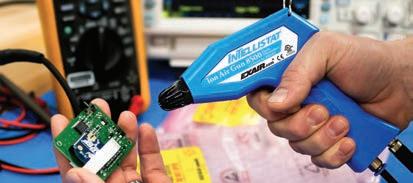




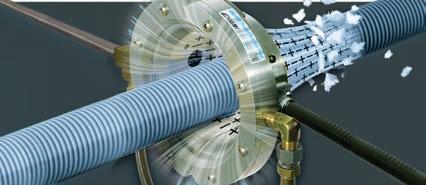




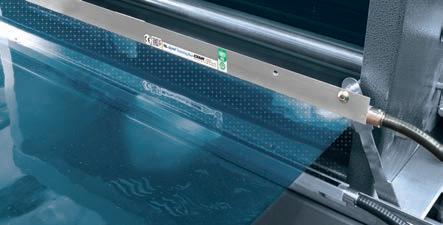



Ion Air Nozzle A mountable static elimination nozzle for assembly stations. Ion Air Gun Patented handheld static elimination for sterile environments. Prevent Shocks, Jamming, Tearing and Static Cling! As humidity decreases, static electricity problems will increase. 11510 Goldcoast Drive • Cincinnati, OH 45249-1621 • Phone (513) 671-3322 FAX (513) 671-3363 • E-mail: techelp@exair.com • www.exair.com Manufacturing Intelligent Compressed Air® Products Since 1983 @EXAIR Improved Performance and Greater Durability! Static Eliminators Remove Static Electricity and Dust! • Materials tear, jam or curl • Webs and films cling to themselves • Electronic sensors fail, making false readings • Hazardous sparks or shocks occur • Product clings to itself, rollers and machine beds • Dust attraction ruins surface finishes Super Ion Air Knife™ Produces a laminar sheet of airflow that floods an area or surface with static eliminating ions. Super Ion Air Wipe™ The uniform 360° ionized airstream neutralizes and cleans continuously moving surfaces. Ion Air Gun™ Eliminates static and dust from parts prior to assembly, packaging, painting or finishing. Ion Air Cannon™ Ideal for hard to reach spaces or confined areas that require a concentrated ionized flow. Ion Air Jet™ Delivers a concentrated blast of ionized air prior to shrink wrapping, packaging and printing. Ionizing Bars Eliminates static cling, dust attraction and jamming on paper, plastics and film. Learn More About Our INDUSTRIAL Static Eliminators Today! https://exair.co/18_470
CLEAN TECHNOLOGY PUROLATOR TO ELECTRIFY FLEET
Over the next seven years, Purolator plans to invest approximately $1 billion to electrify its Canadian network. Over $100 million is set to be invested in 2023.
“Purolator was the first Canadian courier to launch fully electric curbside-delivery trucks nationally. Our ambition is to be the greenest courier company in Canada, and with this investment, Purolator will take yet another important step toward a more sustainable future and healthier planet,” said John Ferguson, President and CEO, Purolator. “We’ve s et ambitious goals for ourselves and are working with our customers and partners every day to reduce our carbon footprint and protect our environment.”
T he investment will fund over 3,500 fully electric last-mile delivery vehicles and electrification of over 60 terminals across Canada. It is also expected to reduce the company’s GHG emissions in 2030 by 80,000 tonnes of CO2e.
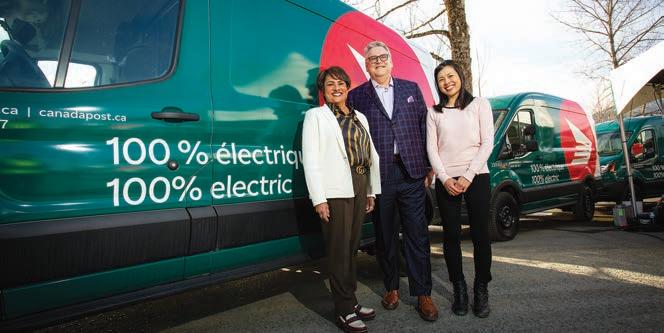
Purolator will add over 100 EVs to its fleet in 2023 and 150 more in 2024. Vehicles that will be added are Ford E-Transit, BrightDrop Zevo 600, and Motiv Power Systems EPIC4 models.
Purolator will begin deploying 25 Ford E-Transit vans in London, Ont.; Richmond, B.C.; and Quebec City, this month. A further 55 Motiv and 15 BrightDrop models, along with several low-speed vehicles and electric cargo bikes (e-bikes), will be added later this year.
CANADA POST TO USE EVS AT ITS NANAIMO DEPOT
Canada Post’s Nanaimo, B.C. depot will use battery-electric corporate delivery vehicles. A total of 14 fully electric cargo vans for collection and delivery services will be replacing internal combustion engine vehicles currently in use.
“Last year, the corporation set aside more than $1 billion to cut emissions and move forward on the electrification of its last mile fleet. This critical investment has led to important progress on Canada Post’s plan to achieve net zero emissions by 2050,” said Suromitra Sanatani, chair
of the board of directors, Canada Post. “Canadians expect their postal service to play a leading role in the country’s transition to a low-carbon future. It’s a responsibility that Canada Post embraces.”
The move is part of Canada Post’s plan to reach net-zero emissions by 2050. It plans to electrify half of its national fleet of 14,000 vehicles by 2030, and in turn, the entire fleet by 2040.
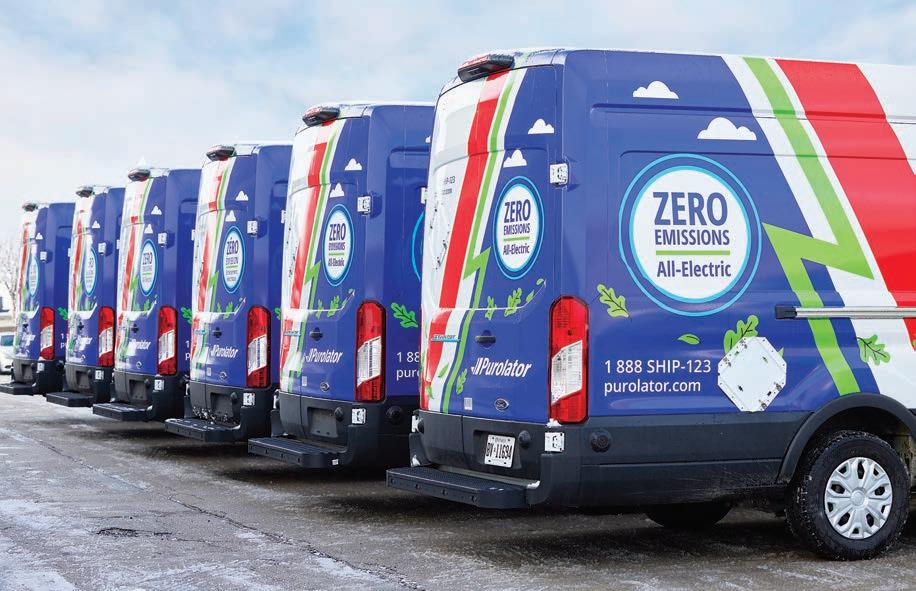
“Over Canada Post’s long history, the postal service has always evolved to meet the changing needs of Canadians and businesses,” said Doug Ettinger, president and CEO, Canada Post. “Our transformation plan invests billions of dollars into service, capacity and greening our operations – because we need to deliver for Canadians, whether that’s shipping parcels or helping to build a more sustainable future. When you look at the size of our network, this depot may be a small first step, but it’s an important one as we start to build momentum.”
AEROSPACE GOVERNMENT OF CANADA INVESTS IN AEROSPACE INDUSTRY
The Government of Canada has invested over $11 million, through the Aerospace Regional Recovery Initiative in southern Ontario’s aerospace sector.
“The aerospace sector here in Burlington and across the region is growing. Businesses are improving their productivity so they can become regional and global leaders and supply their products across the world,” said the Honourable Filomena Tassi, Minister responsible for the Federal Economic Development Agency for Southern Ontario. “Our government knows that when we invest in businesses, they can continue to compete globally, create jobs, and contribute to a strong economy right here in Canada.”
RAMPF Composite Solutions Inc., a Burlington-based manufacturer for the aerospace, defence, consumer
Visit plant.ca for the latest products, news and industry events.
PHOTO CREDIT: Pinpoint National Photography
NEWS
Purolator plans to use Ford E-Transit (pictured), BrightDrop Zevo 600, and Motiv Power Systems EPIC4.
14,000
Size of Canada Post national vehicle fleet, which Canada Post plans to be fully electric by 2040.
(From left): Suromitra Sanatani, Doug Ettinger, and Sally Dam, Canada Post.
6 Plant / Spring 2023 PLANT.CA
Photo credit: Purolator
products and medical sectors, will see an investment of nearly 2.3 million. It will purchase new equipment, green its operations, expand into new markets, increase revenue, and create 15 new jobs.
Women in Aerospace - Canada, a Hamilton not-for-profit organization dedicated to expanding women’s visibility in the aerospace sector, gets over
$330,000 for the Advancing
Women in Aerospace Leadership Program. The program will provide professional development, training , and mentorship programs at no cost for 150 women currently in the aerospace sector or women looking to transition into the sector to improve their leadership skills.
“Canadian Aerospace has the benefit of so many talented
women in the industry, however, women continue to be significantly underrepresented in the industr y, especially at leadership levels,” said Nancy Barber, president, Women in Aerospace – Canada. “To continue to be at the forefront of the industry to compete internationally, we need to increase levels of diversity to ensure we have the talent to continue to innovate. We are incredibly grateful that FedDev Ontario recognizes the criticality of supporting underrepresented groups in aerospace and is providing Women In Aerospace – Canada with the funding to continue to develop women to be successful in our industry.”
Others receiving funding were: Nanowave Technologies Inc., and NWI Precision Tube ULC.
The investments look to help increase manufacturing capacity and productivity, green operations, provide professional skills development and support over 180 jobs across southern
LOGISTICS
ENDRESS+HAUSER NEW REGIONAL LOGISTICS HUB
Endress+Hauser has opened a new 48,000 square-foot regional logistics hub in Indianapolis, Indiana.

The facility will be used for cross-docking logistics, including shipping products from manufacturer directly to customer. The hub will assume the function of a warehouse. The centre will bundle inbound orders from overseas locations and distribute them to their designated sites in North America.
In partnership with Hellmann Worldwide Logistics, Endress+Hauser will strengthen logistics capabilities for Canada, the United States, Mexico, and internationally in terms of response time, throughput time and on-time delivery.

23_001273_PLANT_APR_CN Mod: March 8, 2023 2:08 PM Print: 03/10/23 12:48:31 PM page 1 v7 ORDER BY 6 PM FOR SAME DAY SHIPPING COMPLETE CATALOG 1-800-295-5510 uline.ca OVER 41,000 ITEMS ALWAYS IN STOCK π PLT_Uline_April23.indd 1 2023-03-16 2:43 PM
Ontario’s aerospace sector.
@PLANT_Magazine Spring 2023 / Plant 7
Photo credit: Endress+Hauser
EV future takes centre stage
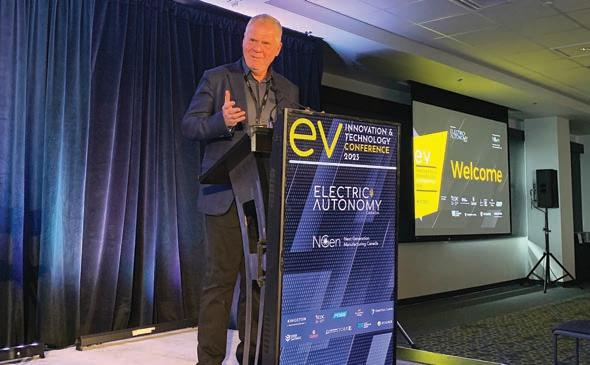 BY MARIO CYWINSKI
BY MARIO CYWINSKI
Industry heavyweights were on hand to discuss how to move forward.Vehicle manufacturers were represented by Marissa West, President and Managing Director, GM Canada, and Jean Marc Leclerc, President and CEO, Honda Canada. Parts suppliers by Linda Hasenfratz, Executive Chairman and CEO, Linamar Corporation, and Ahmed Elganzouri, Sustainability Director, Magna International Inc. The Honourable Victor Fedeli, Minister of Economic Development, Job Creation and Trade, represented the Government of Ontario, while representatives from associations, unions,
suppliers, and others we also on hand.
“NGen partnered with Electric Autonomy to host the largest conference of EV specialists that has been held in Canada to date - and it is only the beginning,” said Jayson Myers, CEO, NGen. “It brought together industry leaders from across the EV value chain to discuss the future of the industry and what needs to be done to address the significant innovation and skills challenges that still lie ahead. Two key themes emerged - the importance of collaboration and the need to move fast to take advantage of the
changes that are transforming the auto industry worldwide.
A panel on Retooling the Manufacturing Landscape was the highlight of the day, as it included West and Hasenfratz, who were joined by Lana Payne, National President, Unifor; Rachel Doran, Director of Policy and Strategy, Clean Energy Canada; and moderator John Stackhouse, Senior Vice-President, Office of the CEO, RBC.
“A consistent theme across the day’s speakers and panels was the need for a sense of urgency to seize the opportunities and address the

 Photo credit: Mario Cywinski)
Photo credit: Mario Cywinski)
The EV Innovation and Technology Conference 2023 took place at the Barrett Centre for Technology Innovation on the campus of Humber College. It brought together the industry to look at and move forward the electric vehicle manufacturing space in Canada.
INDUSTRY EVENTS FEATURE
(Left) Jayson Myers, CEO, NGen welcomed guests. (Right) The room was packed for the conference.
8 Plant / Spring 2023 PLANT.CA
Retooling the Manufacturing Landscape panel.
challenges of building a globally competitive EV supply chain in Canada,” said Nino Di Cara, president, Electric Autonomy, the event’s organizers. “The speakers made it crystal clear that we’re going to need all stakeholders in the industry to embrace innovation at speed while maintaining our national values and objectives around sustainability.”
on EV Future Market Readiness, by John Laughlin, Chief Technology Officer, NGen, and Matthew Fortier, President and CEO, Accelerate.











































































































































































































Other panels looked at Building a Sustainable Supply Chain: Canada’s ESG Edge, A Leap Forward: Next-Generation Batteries, and Bridging the Talent Gap. The event’s fireside chats discussed the Investment Landscape for EV-Sector Businesses, and What does the IRA mean for Canada?

“I came away from the event feeling inspired about the potential for Canada to be a global industr y champion in the electric vehicle powertrain supply chain,” said Chris Hill, CEO, C. Hill Management Inc. Fleet Advisory Services.
Keynotes for the day were presented by LeClerc, who presented to closing keynote (about the need for industry cohesion to tackle issues such as infrastructure, having more urgency, and developing a skilled workforce), as well as a keynote


The conference concluded with a cocktail reception featuring a fireside chat with Fedeli and Myers.
Also, part of the conference was an exhibitor section as well as an electric vehicle ride and drive.


For more on the conference, visit https://electricautonomy.ca/ ev-innovation-technology-conference-2023/













































































































 Mario Cywinski is the editor of Plant magazine, MRO magazine, and Food and Beverage magazine, contact him at mcywinski@plant.ca..
Mario Cywinski is the editor of Plant magazine, MRO magazine, and Food and Beverage magazine, contact him at mcywinski@plant.ca..
As one of the largest distributors of Motion & Control, Industrial Filtration and Automation solutions in Canada, Wainbee’s Technical Experts and Application Specialists are well versed in industry requirements in local markets, and can provide leading expertise for part sourcing and technical problem solving. 1-888-WAINBEE (924-6233) | WAINBEE.com Technical Expertise System Integration Coast-to-Coast Tech Support Wainbee continues to support customers, ensuring production doesn’t stop and scheduled maintenance still takes place. Wainbee is here to support customers coast-to-coast across Canadaa partnership you can count on! Motion & Control · Filtration · Automation Solutions PLT_Wainbee_April23.indd 1 2023-03-14 1:16 PM
@PLANT_Magazine Spring 2023 / Plant 9
“I came away from the event feeling inspired about the potential for Canada to be a global industry champion in the electric vehicle powertrain supply chain.” -C. Hill
Honda’s journey to retool Alliston plant
Plant spoke with Jeff Hansen, North America, CR-V Engineering Project Leader at Honda of Canada Mfg. about Canada becoming the lead plant for Honda’s CR-V Hybrid.
BY MARIO CYWINSKI
Honda of Canada Mfg (HCM) in Alliston, Ontario was recently named the global lead plant for CR-V Hybrid production, and in turn, the plant needed to do a lot of work to get ready. This included retooling the plant, implementing processes, equipment, and materials, just to name a few.
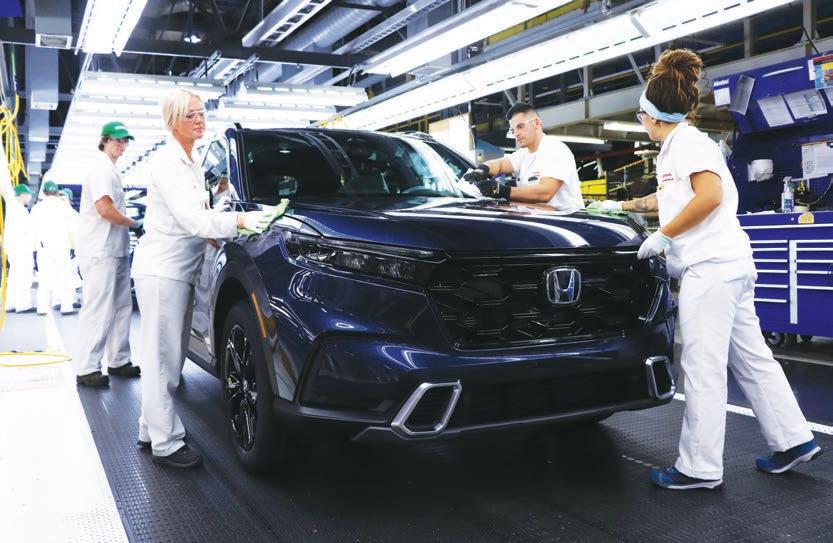
Plant discussed the ins and out of how the process played out.
Can you speak about your role at the plant?
Jeff Hansen: My role is to co-ordinate the CR-V new model project across three assembly plants and three powertrain plants within North America. I lead teams of associates who are responsible for supplier development, product quality, engineering, and manufacturing. These three pillars work in collaboration within HCM, but also lead these related areas for all CR-V sites in North America.
This HCM team collaborated with the Japan-based design centre from the beginning stage of development until project closure finalizing this month. This team was responsible for project timing, budget, procurement, installations, testing, training, and product quality achievement.
How did HCM become the global lead plant for CR-V Hybrid production, and what does it mean for the company?
Hansen: The original plan was for the Japan flagship plant (Yorii) to lead globally. However, after consideration that North America is number
one in market demand for CR-V, Honda Motor Company decided that the lead function should be assigned to HCM, where the highest volume of CR-V is produced in one site. Coupled with considering business conditions, HCM had demonstrated strong capabilities of new model development and leadership through prior first time launches for models such as the Odyssey, Pilot, MDX and Ridgeline. This project has positioned HCM as a very capable entity within the Honda organization and as a resource for key responsibility and growth.
In all, how much of an investment was the CR-V hybrid at HCM?
Hansen: The FHEV investment is complicated to breakdown, considering requirements for the supply base
including engines and transmissions from Honda’s Ohio facilities. Within HCM’s walls, FHEV specific areas required approximately $12 million USD of unique investment; this is in addition to the base investment required for CR-V.
What needed to be done to get the plant ready for CR-V hybrid production? How long did it take to retool the plant? What was involved?
Hansen: Truly, the project required over four years of preparation, which includes several cycles of design maturation utilizing HCM-based engineers working closely with sister facilities in Ohio, Indiana, and Japan. This type of work vetted out the design for manuf acturing to ensure tooling, process, equipment, and materials were optimized.
Photo: Honda Canada Inc
AUTOMOTIVE Q&A Q Q Q Q 10 Plant / Spring 2023 PLANT.CA
Secondly, product testing and evaluations were carried out in various stages to ensure product quality and performance achiev ement. New tooling, equipment and processes were installed and tested over a oneyear period. Unique to Honda, this activity is completed during weekends and the two annual shutdowns, therefore never stopping regular mass production for any extended period.
The hybrid technology is really dedicated to the powertrain system. As the primary addition, a new IPU (integrated power unit) sub-assembly line was developed by HCM engineers. Other change points in body str ucture and final assembly were primarily modification to the base petrol model.
What exactly needed to be changed exclusively for the hybrid models? Can you speak about the

new electrification hybrid components area?
Hansen: Specific to the hybrid, the rear floor pan area in the body became a subcomponent manufactured locally and then loaded with automation to the weld line. The IPU is a new sub-line where the Panasonic battery is assembled with other components to create the IPU module. This module required an assist mechanism to ensure safe and accurate locating in the final assembly process. The hybrid requires other connections to the PCU (power control unit) and software confirmation to confirm system function and performance through various in-line tests.
Is any special training needed for HCM team members for the new hybrid models?

Hansen: Training was carried out for all new processes related to hybrid assembly. The first and foremost training involved safe handling of battery components including methods and protocols for working with high voltage. Those associates working directly with the IPU subassembly are required to wear C2 classed uniforms that resist fire if an electrical malfunction created a thermal event.
Safety was the very first endeavor by the project team with suppor t of the corporate safety group, who benchmarked other companies that work with similar technologies. With the IPU subassembly, some electrical components are small and require finer dexterity compared to most assembly components. Associate input was essential to ensure the process design could meet associate needs and ensure quality was maintained at each process step.
How much of a role has automation played in terms of production at HCM?

Hansen: Specific to hybrid production, most processes are a combination of human and automation. Very few hybrid specific processes are fully automated.
Are any other models being built at the HCM plant?
Hansen: HCM Line 2 builds both petrol and FHEV CR-V. HCM Line 1 builds the Civic four-door. HCM Engine line builds engines for HCM Line 1 Civic production.
Mario Cywinski is the Editor of Plant, MRO, and Food and Beverage magazines, and a member of the Automobile Journalists Association of Canada. Contact him at mcywinski@plant.ca.
PLT_Berner_April23.indd 1 2023-03-16 10:39 AM
Q Q Q Q @PLANT_Magazine Spring 2023 / Plant 11
Add the environmental observations during your mapping exercise
Leverage your value stream mapping exercises to become more environmentally friendly.
BY RICHARD KUNST
Enterprise value stream mapping takes you beyond the traditional shop floor and dives deep into the information and communication flows of your operation. If your annual operating plan is not supported by value stream maps, your plan is just a wish.

Enhance dialogue boxes within value stream maps to capture infor mation revolving around the three pillars:
• Inspired and motivated people (cultural);
• Robust processes (physical assets and technology); and,
• Lean operations (process DNA).
For example, maps can capture casual absenteeism, turnover, amount of people cross-trained, tenure and the 5S score. Since the power of lean is about respect for people, look at operations with high turnover to make them better.
Adding environmental observation during your mapping exercise expands the scope of opportunity. A key component of value stream mapping is walking and observing the current state by being there. I’m amazed when facilitating a mapping session, how often managers find out new attr ibutes of how the value stream is operating.
As you walk your value stream, look at it from an environmental perspective, in addition to the other attributes. Begin by looking in garbage cans and do a trash audit; what and why are certain things being placed in trash cans? Also, look in your swarf container. Creating this swarf costs money, so what can be done to minimize the creation of swarf?
For example, a machine shop had an employee install a simple oil filter and collection container at the bottom of the swarf container to re-capture coolant that could be recycled back into the machine, saving the company money.
After many iterations of value stream mapping, it becomes more difficult to find improvement opportunities; therefore, expanding your horizon to look at environmental opportunities is a natural and profitable extension of observation. For example, what you find in the trash can may be a symptom of greater opportunities.
• Excessive use of rags or wipes can indicate that the machine has a leak.
• Fumes could indicate a toxic emission or that you are over-processing within the operation.
• Noise is the silent killer and we
need to constantly find a way to make for quieter operations.
• Compressed air leaks: visit your plant during a quiet time, turn on your compressor and listen for leaks. Sometimes just a simple tightening of a joint will fix the problem and save you money.
• Water, coolant spills, and pumps consume energy. If liquids are being pumped onto the floor, you are wasting energy.
• Amp meters can be a friend. Log the size of motors being used and the amount of current they are drawing.
• Pre-star t: many operations require machines to warm up before they will perform effective operations; idle time can be costly
• Garbage audit: dump that garbage can onto the floor and separate landfill items from potential recycling. Ask how land-fill items can be reduced
or your recycling program can be enhanced.
In addition, look at what machines will be started at the beginning of shift or after the completion of a scheduled break. If several machines are started at the same time, this will create a peak in your energy consumption. Many companies pay for energy consumption based on the peak usage determined during the day. Staggered breaks can create savings.
With diminishing resources, we see organizations trying to rush mapping exercises, when they need to slow down and observe.
Richard Kunst is an author, speaker and seasoned lean practitioner based in Toronto, who leads a holistic practice to coach, mentor and provide management solutions to help companies implement or accelerate their excellence journeys. You can reach him at www.kunstsolutions.com.
Photo: OpturaDesign/Adobe Stock
INDUSTRY EVENTS FEATURE 12 Plant / Spring 2023 PLANT.CA



SUBMIT APPLICATION HIRE STUDENTS GET WAGE SUBSIDY Get Talent Get Money Get Started apply today Today’s students will become part of your workforce. You can help shorten the distance. 1
3 WORK INTEGRATED LEARNING WWW.EMCCANADA.ORG/WIL
2
Look out for signs of eye discomfort
symptoms are present together, they are often diagnosed as computer vision syndrome. However, manufacturing work that requires a high degree of visual focus and mental concentration on each task can also result in the same symptoms.
It is important to note that eye discomfort is also a common ergonomic injury in this industry. Eye discomfort is common among workers whose tasks require prolonged visual focus and those who spend extended periods of time looking at a screen. Not only can eye discomfort result in decreased productivity, but it can increase the risk of health and safety incidents in the workplace.
Many symptoms of eye discomfort can be addressed with proper lighting. When exposed to poor lighting,
workers often alter their posture to relieve the strain on their eyes. Addressing the visual ergonomics of their workstations can help ease discomfort in their neck, shoulder, and back.
Look out for the symptoms and sources
Eye discomfort can include many symptoms including eyestrain, dry eyes, blurred vision, red or pink eyes, burning and light sensitivity, and headaches. Discomfort can also be felt as pain and stiffness in the shoulders, neck and back. When some of these
There are several contributing factors to eye discomfort. Many are related to lighting and workstation setup, such as an improper distance between the eyes and machinery, poor resolution or picture quality in monitors, glares on screens, and poor lighting. A lack of colour variation in the work environment can also contribute to eye strain. Low ambient humidity or poor indoor air quality can also irritate the eyes.

There are non-physical factors to be aware of, as well – psychological factors such as lack of autonomy or perceived conflicts with co-workers or management can result in workers experiencing tension and eye fatigue.
Vision changes gradually as we age, limiting our ability to focus on objects at close range with the naked eye. Uncorrected vision is a common source of eye discomfort, so have your
Photo: ©insta_photos/Adobe Stock
When people think of eye-related hazards in the manufacturing industry, what typically comes to mind are dust, chemicals, and flying objects.
HEALTH AND SAFETY FEATURE 14 Plant / Spring 2023 PLANT.CA
BY CANADIAN CENTRE FOR OCCUPATIONAL HEALTH AND SAFETY (CCOHS)
vision checked every one or two years, as recommended by your eye specialist. Provide your eye examiner with information about your job and consider using task-specific glasses if recommended. Safety glasses with a g radient tint can also help to neutralize glare from overhead lighting without darkening the workstation.
Lighting and workstation setup
Proper lighting and workstation setup can resolve most eye discomfort symptoms. The right lighting provides enough illumination so workers can see fine details clearly but are not blinded by excessive brightness.
Anytime your facility upgrades its lighting system, be sure to check with workers to ensure
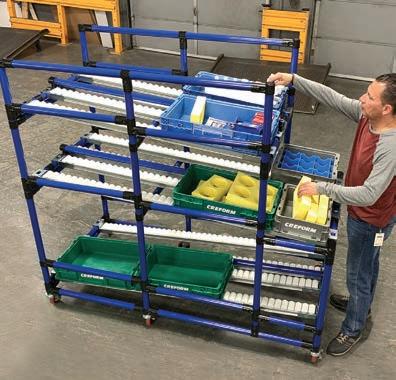
they aren’t experiencing eye discomfort as they adjust to the new lighting. Light should come from the right direction and not cast obscuring shadows. Ideally, workers should be able to adjust lighting to their own comfort level at each workstation, rather than relying solely on overhead industrial lighting.

Improving the workstation setup will also help reduce eye and neck strain. If your workplace doesn’t have an in-house ergonomist, it is good practice to designate or consult with someone who is trained, competent, and knowledgeable about workstation set-up to address any ergonomic issues as they arise.
Training and prevention
Ergonomic hazards and injury prevention practices should be
covered in your workplace health and safety program. To help prevent ergonomic-related eye injuries, employers should identify and assess risk factors and ensure safe work practices are in place to reduce or eliminate the risks.
Prevention efforts should also include regular training and education. Be sure to train workers on the risk factors for eye discomfort, and how to prevent and reduce them before any signs or symptoms develop. Provide workers with education on how to set up ergonomic workstations and work practices to reduce the risk of eye injury.

Encourage workers to give their eyes a “stretching” break to help prevent eye strain and fatigue. Focusing on objects at the same distance and angle for prolonged periods of time is a major contributor to eye strain, so allow workers to take periodic breaks from their tasks to rest their eyes. Eye specialists recommend the “20-20-20 rule.” At least every 20 minutes, take a 20-second break and look at something 20 feet away. Focus your vision on distant objects, then blink several times.
Lastly, encourage workers to come forward to their manager or health and safety representative at the first signs of discomfort, because like all repetitive strain injuries, symptoms worsen over time.
The Canadian Centre for Occupational Health and Safety (CCOHS) promotes the total well-being — physical, psychosocial, and mental health — of workers in Canada by providing information, advice, education, and management systems and solutions that support the prevention of injury and illness. Visit www.ccohs.ca for more safety tips.
THE ART OF WORKFLOW... SEE IT. MOVE IT. MANAGE IT. www.creform.com • 800-839-8823 From skatewheel conveyors and AGVs to visual and inventory management... controlling workflow is key to the success of any operation. With Creform rollers, conveyors, carts, workstations, flow racks and AGVs you control your workflow, regardless of the part in process and the time. And its not just for boxes or totes. One piece flow or a series of products, all to make the best use of your structure. CRE-801 7.875x5.25.indd 1 1/11/23 1:51 PM PLT_Creform_April23.indd 1 2023-03-10 8:49 AM
Eye specialists recommend the “20-20-20 rule.”
@PLANT_Magazine Spring 2023 / Plant 15
At least every 20 minutes, take a 20-second break and look at something 20 feet away.
Opportunities in clean technology for manufacturers
Plant spoke with Dennis Dussin, president, and owner at Alps
BY MARIO
Alps Welding Limited is a custom metal fabricator in Woodbridge, Ont, with an over 50-year history. In that time, it has manufactured a wide variety of process equipment, including pressure vessels, heat exchangers, piping systems, and stacks, for the energy, chemical, and food industries.
In recent years, Alps has become a supplier to clean technology designers and is increasingly manufacturing equipment for customers to reduce their energy and water use and control their emissions.
Plant discussed how sustainability and carbon reduction trends impact manufacturers, and the opportunities and barriers that manufacturers face.

QHow can manufacturers be more sustainable and reduce their carbon footprint, by using clean technology in the manufacturing space?
Dennis Dussin: An obvious place to start is to retrofit lighting and heating systems. Many companies have already done some of this, and it’s the low-hanging fruit. Lighting systems for manufacturing spaces have become much more effective and efficient recently.
Companies should also look at their operating equipment (machining centres, welding machines, or material handling systems) to see what is elig ible for updating or replacement. New equipment usually uses less energy than older machines and is often more productive.
Technology that helps to eliminate waste or recycle resources is also a big oppor tunity. We fabricate heat exchangers and water filtration equipment for our clients, who have developed systems to capture waste heat or reuse water in their processes.
Manufacturers should be looking at where in their process they see lost energy, wasted inputs, or scrap and whether there is technology that can help them reduce, capture, or reuse those inputs and materials. We continue to see demand for these systems g rowing strongly in the coming years.
Vehicles are another area ripe for electrification, as technology has become cost-effective. We are looking at electrifying our forklifts and company vehicles. We are planning to install EV chargers in some of our parking spaces to encourage employees to start purchasing EVs.
These ideas are about improving efficiency and reducing energy or material use in existing processes. The significant carbon footprint improvements in the manufacturing space will come from electrification of processes currently powered by fossil fuels. You’re seeing this in the current initiatives to electrify steel mills that run on coal. Those are mammoth investments, but there are opportunities to electrify in many manufacturing processes that are smaller in scale.
One area flying under the radar is the improvements that can come from simple process improvement. Too often, we focus on technological solutions to problems, when there may be considerable benefits to simply redesigning processes. Any company that has implemented lean manufacturing principles finds enormous waste and inefficiency in any manufacturing process, much of which can be reduced or eliminated by changing the process. These changes could involve changing the sequence of operations, floor layout, or employees’ tools, information, and training.
Photo: ©Sutthiphong/Adobe Stock
Welding Ltd., about the use of clean technologies in the manufacturing space. What should be a priority, how to implement cleantech, successful case studies, and more.
CLEANTECH Q&A
CYWINSKI
16 Plant / Spring 2023 PLANT.CA
Although large companies tend to have invested in some version of a lean journey, many small and medium-sized manufacturing companies are behind the cur ve. This is a missed opportunity and one that policymakers should focus on ways to make significant gains quickly and cost-effectively.
These ideas require some amount of up-front investment, but over the medium to long term, they offer positive financial returns to manufacturers and reduce their carbon footprint. This is even more so if you can find municipal, provincial, or federal funding to offset part of the cost. These initiatives aren’t just good for the environment; they’re good business investments.
Further, many companies find that in their journey, they see intangible benefits when they make these improvements, such as better employee retention and engagement and enhanced reputational standing among their customer s and in the community where they operate. It’s hard
to put a value on that.
QDo you see clean technology as being a priority for many companies in manufacturing.
Dussin: I see a clear division among manufacturers in Canada now. Some companies see the oppor tunity in clean technology and are pursuing it aggressively. However, many manufacturers still see it only as an increased cost to their operations and a barrier to competitiveness.
For it to become a priority, we need to start seeing it as an opportunity to improve our operational efficiency and competitiveness. Further, it’s not just an oppor tunity to improve our own carbon footprint. The bigger opportunity is to help other companies reduce their carbon footprints.
Large companies are making considerable environmental investments in their operations and are looking for Canadian suppliers to support them. Often, they purchase technology and exper tise from other countries, even though they prefer to “buy Canadian.”
At Alps Welding, most of our current fabrication projects are related to clean technology, including water treatment, heat exchangers, emissions control, alternative energy, or battery manufacturing. This will continue in the long term.
Entire new industr ies are emerging in clean technology: EVs, battery manufacturing, and different forms of nuclear power. Canadian manufacturers can form part of the supply chain for these industries.
Most importantly, if Canadian manufacturers see the opportunity to supply the clean technology industry, we can join the global supply chain and expor t our skills and capabilities. Canada could and should become a global leader in expor ting clean technology and manufacturing for the sector.
This is the most significant opportunity for Canadian manufacturers in clean technology.
If Canada eliminated its carbon emissions entirely, we wouldn’t significantly impact global emissions as we are a small country. However, if we supplied clean technology to other countries, we could have a disproportional impact on global emissions and truly “punch above our weight.”
Not enough manufacturers are seeing this opportunity, and so aren’t making clean technology enough of a priority.
QWhat are some of the obstacles that Canadian companies face in their path to go green? How can this be overcome?

Dussin: Cost is an obvious one, because adopting clean technology requires investment. Although there are government prog rams to assist with these investments, there’s no getting around the fact that it will require up-front expenditures.
This is a real barrier in today’s uncertain economic environment, with higher interest rates.
Viewing clean technology as only a threat or a cost instead of an opportunity is also an obstacle.
A more significant and less obvious obstacle is a lack of knowledge, especially among small and mid-size manufacturers. We are experts in our products and processes but not in the latest clean technology. We don’t always know the current state of technology, what will work in our operation, and the expected benefits. We often must rely on the sales promises of clean tech companies, and it’s hard to get objective advice on the right path to take. There’s a risk that we’ll choose the wrong technology that doesn’t provide the benefits promised, or it will become obsolete in the short term. This risk stops companies from making the financial and operational commitment required to adopt clean technology.
Whether you need to deliver a skid of blocks to a jobsite or move a 16,000 lb. load of steel, Sellick has the forklift that is right for you. We have been engineering and manufacturing rough terrain forklifts for over 50 years and our nationwide dealer network offers superior support for all your parts and service requirements. Call toll-free or e-mail us today for all your material handling needs.

1-877-SELLICK (735-5425) sales@sellickequipment.com Lift, Load and deLiver with SeLLick! Lift, Load and deLiver with SeLLick!
PLT_SELLICK_APR23_CSA.indd 1 2023-03-07 1:34 PM
@PLANT_Magazine Spring 2023 / Plant 17
CLEANTECH Q&A FEATURE
Manufacturers need help just to get started down the path. When they get started and see benefits, they will continue looking for further opportunities. I think it’s especially true when they see the intangible benefits they didn’t expect, like greater employee engagement and retention, and stronger reputation among customers.
QWhat do Canadian companies have to do to become more carbon neutral? Do you feel complete carbon neutrality is an achievable goal?
Dussin: Companies can do many things to reduce their carbon footprint, and they can also become part of the clean tech supply chain to help reduce carbon emissions outside of their companies. However, reducing carbon footprints is different from achieving carbon neutrality.
Carbon neutrality is achievable, but not simply through minor incremental improvements and piecemeal reductions in emissions. It will require much more significant changes.
Companies will need to look at their processes from beginning to end and re-think them completely to achieve carbon neutrality. From the materials we use, where we source them, how we handle and process them, how we sell and transport them, and how we handle waste and scrap. We can improve individual steps in the process to reduce our footprint. Still, to achieve neutrality, we’ll have to look at the entire process, including all the linkages with our supply chain and customers.
It’s an ambitious goal and one worth pursuing. Companies, especially small and mid-size companies, cannot do it independently. It will require coordination within supply chains and jurisdictions.
QHow can governments help put Canada on the right road to a cleaner future and help support manufacturing in the adoption of clean technology?
Dussin: Governments need to continue, and to increase, funding alongside companies to invest in clean technology projects. Companies won’t incur the costs alone,
especially in the current economic climate. Governments need to start funding process improvement initiatives, instead of just investments in equipment or technology. There is a lot of low-hanging fruit in optimizing manufacturing processes to reduce waste, which is a missed opportunity.
Just as important, governments need to help de-risk these investments, and it’s not just about the cost. Companies need trustworthy, objective advice and data on which technologies and process improvements will work for them. They need help connecting with other manufacturers or the expertise they need to make these investment decisions.
Governments should also help manufacturers tap into export opportunities in the clean technology sector. Many small and mid-sized manufacturers are part of the clean technology supply chain that aren’t actively involved in exporting their technology and projects. Governments can connect these companies with potential markets outside of Canada and impact reducing emissions globally, not just at home.
If we aim to achieve true carbon neutrality, governments will also have to make enormous investments in the economy’s systems and infrastructure. For example, if we all electr ified our production processes and transportation completely, it’s unlikely we’ll have enough “clean” electricity. This is particularly true
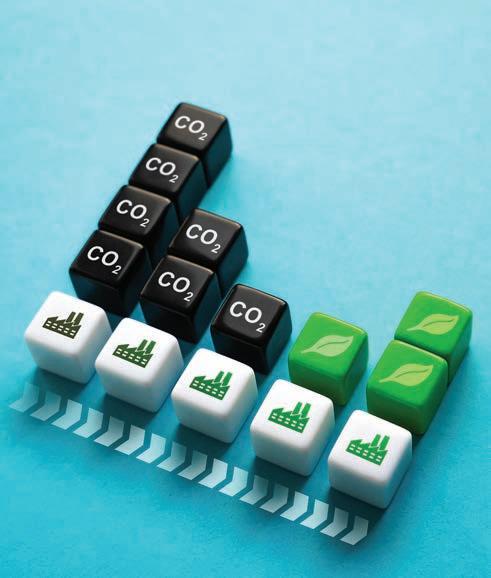
outside of Ontario and Quebec, which have significant nuclear and hydro. Governments will have to invest in significantly more clean electricity production and foster the development of emerging new industries like hydrogen, new battery technologies, and small modular nuclear reactors, to name a few.
QDo you have a case study or example of successful clean technology implementation?
Dussin: Over the last few years, we have built a series of large heat exchangers for an Ontario clean technology company, who have sold their system to a major oil sands operator. Our customer, Combustion & Energy Systems, designs condensing economizers that recover energy and water from industrial exhaust gases. The end-user has made the investment, along with some government f unding, and is seeing significant benefits in terms of both saved energy and water.
The project has helped them reduce their energy use and carbon emissions while at the same time reducing waste and saving money. By investing in this system, they’ve proven the benefits at a large scale, such that other companies can now make similar investments at much lower risk. The data they’ve generated by operating the systems can de-risk the investment for other potential end-users.
Further, our customer, and by extension, we at Alps Welding, have always been exporters, primarily to the U.S. In proving this system’s effectiveness, we can look together for opportunities outside of Canada where it could benefit and generate savings and emissions reduction.
We frequently see this kind of opportunity, where we work with Canadian technology companies to build systems that improve efficiency and environmental performance. We see that there’s an opportunity to scale up these collaborations both in Canada and in the export market, if we can work together with end users and governments to eliminate some of the barriers standing in our way.
Photo: Andrii Yalanskyi/Adobe Stock
18 Plant / Spring 2023 PLANT.CA
Mario Cywinski is the Editor of Plant, MRO, and Food and Beverage magazines, and a member of the Automobile Journalists Association of Canada. Contact him at mcywinski@plant.ca.
Why Cleantech need a customer-centric culture
Recently, I took my car to a new mechanic.We had been chasing a vibration issue with our local dealership, but my wallet and patience were nearly empty.
We took the car to the dealership on two separate occasions, paying to have the wheels rebalanced and the front end aligned, at the recommendation of the service technician. Unfortunately, the vibration remained.
When I told the service technician the vibration was still evident, she shrugged and said, “Well, you are going to have to speak with my manager.”
The service manager was aware of the issue and quickly told me that the vibration fell “within tolerance.” It was clear he expected no further discussion. Asking a second time what other options there are to eliminate the vibration, he responded “Mr. Casemore, there is nothing wrong with your vehicle.”
As you might imagine, I wasn’t pleased. In attempting to ignore the vibration, my fillings from my teeth were slowly dislodg ing.
Still frustrated by the dealership’s response, I stopped by another garage, and once inside, approached the service technician, explaining the problem.
He said “I know exactly the problem you’re having, as we have another customer with the same year, make, and model of vehicle, and they have had the same issues.”
Excited, I asked him to share if they had resolved the issue. He explained that they had replaced a part that had worn out prematurely. As you can imagine, the vehicle was left with the technician, and they solved the problem.
As a result of this incredible experience, I began sharing my story. Telling my friends about the problem, sharing the name of the garage and the technician that assisted. Also, sharing the story when giving speeches to sales teams and organizations.
The point is our employees make the difference in sustaining and growing our sales.
Applying customer-centric mentality to cleantec
Cleantech is a relatively new sector that is experiencing significant growth. This, in turn, is dr iving further industry expansion, which means we need to hire more people.
The people we hire for technical expertise, engineering acumen, accounting, or production must also have a customer-centric mentality. To continue the g rowth, we must put our customers’ needs, demands, and expectations fir st.
You see, as more companies come online and new products continue to evolve, there will be more competition. As competition enters the market, the g reat differentiator becomes our people.
How engineering interacts with the customer during the design phase. How accounting follows up with a customer on past due payments. How production considers the impact on a customer when making decisions around quality.
Here is how to ensure your employees have a customer centric approach:

1. Educate employees on how their role both directly and indirectly impacts customers.
2. Br ing customer concerns, complaints, and issues to employees, keeping them apprised of the problems and letting them be part of the resolution.
3. In volve employees at all
levels in front-line customer and sales meetings. Let them experience the voice of the customer firsthand.
A customer-centric culture isn’t just a buzzword; it’s a way of working while always keeping the voice of the customer front and centre.
Remember back to my earlier example about the vibration our car had. Would you rather customers be spreading the good news and positive reviews about working with your company or not?
Too much of one and not the other will stop your business dead in its tracks, even if you are entering a new market, such as cleantech.
Shawn Casemore is a keynote speaker, consultant, and author of three books, including his latest book, The Unstoppable Sales Machine. To learn more about Shawn and his work, visit www.shawncasemore.com.
Cleantech is a relatively new sector that is experiencing significant growth. To continue that expansion, we must put our customers’ needs, demands, and expectations first.
BY SHAWN CASEMORE
WORK CULTURE FEATURE Photo:
@PLANT_Magazine Spring 2023 / Plant 19
©Vodolazskyi/Adobe Stock
greater distance from the reference surface.
jwwinco.ca
PINNACLE LZ-16KG5
frequencies are adaptable to a wide variety of applications.
IDEM TWO-HAND SAFETY CONTROL PANELS
AutomationDirect IDEM two-hand safety control panels, used with a special control monitoring relay, require an operator to use both hands simultaneously during a hazardous operation. This forces operators to keep their hands on the two-hand control actuator.
New IDEM products include a control station with momentary pushbuttons, a control station with zero-force touch buttons, and an empty two-hand control station enclosure for custom configurations. Enclosures are made of die-cast aluminum; replacement buttons are available.
A two-hand control safety relay from IDEM is also offered. All IDEM two-hand control panels and accessories come with a one-year warranty.
www.automationdirect.com
OPEN-ENDED AT8 MOV
AT10 and AT15 with standard widths of 25, 50, 75 and 100 millimetres. brecoflex.com
MULTI-WING PMAX7 FAN
Now available in a medium size (PY L-M), it features a larger cone or pyramid shaped lens providing 360-degree visibility. The medium size also offers the ability to incorporate audible signaling into the same PYRA platform (PY L-MA). This enables separate control of visual and audible signaling for enhanced field customization. pfannenbergusa.com
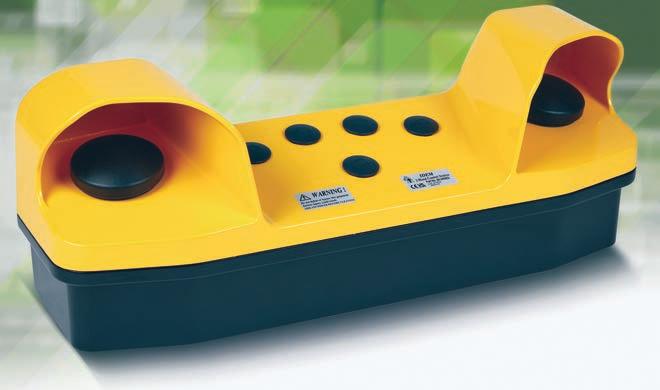
DOWN-THRUST CLAMP
Multi-Wing is high-pressure PMAX7 axial fan has increased airflow, fewer blades, and a lower profile.

Offered in diameters from 1,200 to 1,600 millimetres, modular fans are available with five- and seven-blade configurations with 26°, 31° and 36° pitch angle options. Blades are constructed of polyamide, reinforced with glass fiber, with an operating temperature from -60° to 100°C. The hub is constructed of steel.
PMAX7 fans have tip speeds up to 107 metres per second. PMAX7 fans of 1,600 mm diameter can operate at 1,280 rpm. This high-static pressure fan is compatible with Cojali EV350 fan clutches. multi-wing.com
PYRA SERIES OF LIGHTS
Down-thrust clamp GN 9192 can be fastened to a machine table with T-slots or to a fixture plate, and is made from case-hardened steel. The clamping arm can be swiveled by hand and positioned over the inserted workpiece. Turning and tightening the clamping screw or the adjustable hand lever lowers the clamping arm.
The positioning ring GN 9192.2 can be added as an accessory to the down-thrust clamp. With the help of a positioning pin, the swivel range of the clamping element is limited to 110° to the right and left.
Emergent Vision Technologies’ launched 100GigE line scan camera, the Pinnacle LZ-16KG5. Through its 100GigE QSFP28 interface, the camera reaches a top single line rate of 400KHz and a trilinear rate of 133KHz.
Available in monochrome and colour versions, the camera features the 16Kx16 Gpixel GL5016 CMOS image sensor, with a five-by-five µm pixel cell size and an 81.92-millimetre sensor scanning width.
Both GigE Vision and GenICam compliant, the camera allows cable lengths from one metre up to 10 kilometres without costly fiber converters/repeaters. emergentvisiontec.com

SB12 SERIES BACK PRESSURE/RELIEF VALVES
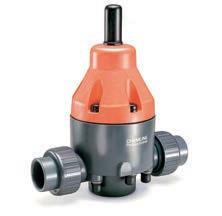
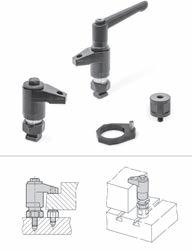
BRECOflex Co. LLC., added AT8 open-ended timing belts to their move-series product line. AT8 MOV open-ended M for linear drives, follows the AT8 BFX version released in 2021.
Move-series are laminate coated polyurethane timing belts with galvanized steel tension members. The timing belts are available open-ended for linear drives in AT8,
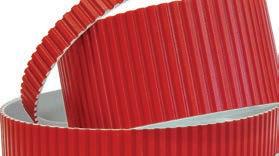
Pfannenberg, Inc. re-launched PYRA LED series, now with 360-degree colour changing LED light. The PYRA series features an RGB LED, with selectable, multiple colours available.
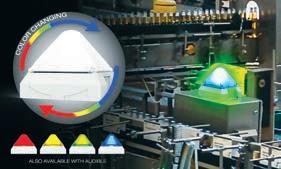
Offered as a single-color LED, it can be field selected to be steady on, blinking, or flashing. With or without an audible alarm, the new series offers high flexibility. Selectable blink and flash
The positioning ring is fastened to the guide element of the down-thrust clamp using pressure screws, and it decreases the stroke length of the clamping element by its own height.
The height-adjusting cylinder, GN 9192.3, is another accessory for the down-thrust clamp, used to increase the clamping height of the standard part.
Height-adjusting cylinders can also be used in combination with positioning elements and clamping pads to position contact points at a
When installed in-line downstream of a pump, Chemline’s SB12 Series
Back Pressure/Relief Valve functions as a back pressure valve. When installed in the branch of a tee it acts as a pressure relief valve.
The SB12 Series has a built-in check valve function that prevents reverse flow. It does not open with every pulsation from a metering pump.
Available in: sizes: 3/8” to 4”, body materials: PVC, PP, PVDF, ends: True union socket, threaded or ChemFlare, seals: EPDM or FKM. chemline.com
For more products, visit: www.plant.ca/technology-centre
NEW PRODUCTS TECH CENTRE
Photo: AutomationDirect
Photo: Pfannenberg
Photo: BRECOflex Co
Photo: Multi-Wing
Photo: Emergent Vision Technologies
Photo: Chemline Plastics
20 Plant / Spring 2023 PLANT.CA
Photo: JW Winco

*E&OE, some conditions apply. See website for details. NEED APPRENTICES? Up to $20,000* in help is available right now! Build your future workforce with support from the Canadian Apprenticeship Service for small and medium-sized businesses. • Free access to employer-apprentice matching services • Free access to mentorship programs • Free access to diversity and inclusion training Apply for your grant at ApprenticeSearch.com/CAS
POSTSCRIPT BY JAYSON MYERS
We need to turn tech leadership into real value for manufacturers
Canada is one of the world’s leaders in cleantech – the broad array of innovative technologies that provide solutions for pollution abatement, energy efficiency, climate change mitigation and adaptation, waste management and remediation, or anything that reduces the environmental footprint of economic activity.
Canada ranks number two in the world on the Global Cleantech Innovation Index. There’s a lot of research happening in the field by industry and academia. Twelve Canadian start-ups are listed among the Global Cleantech 100 list for 2023.There are over 1,100 cleantech companies operating in Canada. They contribute over three per cent of Canada’s GDP and employ close to 350,000 people in well-paying, highly-skilled jobs. The global cleantech market is currently estimated at over $2.5 trillion USD.
However, opportunities are huge, led by increasing demand for clean energy solutions in Canada and internationally. Heavy industr y accounts for 11 per cent of Canada’s greenhouse gas emissions but about one-third of emissions around the world. Electric vehicles are expected to account for over 45 per cent of all new light-duty vehicle sales globally, up from four per cent in 2021. All things considered, the transition to a net-zero economy globally will require global investments averaging $3.5 trillion USD and in Canada between $125 billion and $150 billion every year to 2050.
The year 2050 is when Canada and 72 other countries have pledged to achieve net-zero GHG emissions. Window dressing? Don’t count on it. Governments and businesses are facing mounting pressures around the world from voters and customers,
investors, and insurance companies, stakeholders, and the public at large – young people in particular – to take action to improve environmental sustainability, address climate change, and improve energy and materials efficiency. Roadblocks may be thrown up along the way, but the path to what lies ahead is clear.
For manufacturers, it means more stringent regulations, higher penalties, and new restrictions on production, such as the ban on non-reusable plastics. Producers are being required to track and trace their supply chain to reduce their carbon and overall environmental footprints. At the same time, they are having to take on more responsibility for the full life-cycle management of their products and the waste they generate, leading to greater recycling and new circular manufacturing processes.
You would think business at Canada’s cleantech companies would be booming. For some firms it is. However, overall sales are growing at about the same pace as the economy. What gives?
Some say it’s a commercialization issue, that cleantech companies need to do a better job “productizing” their solutions and developing applications for customers, or they need to find more money to scale up production of their technologies.
Others argue it’s an adoption problem, that Canadian businesses, and especially manufacturers, are too small or too risk adverse to be early adopters, and it’s difficult to scale up a cleantech company based on the Canadian market alone. Both arguments are true, to an extent. It’s a lot more complicated than that.
It’s not just about technology. Manufacturers are looking for solutions. Cleantech may be
part of a solution, but it needs to be integrated with other technologies or existing manufacturing processes to be a useful one. Solution design requires manufacturers, cleantech, and possibly other tech companies, engineering firms, and researchers to work together to design and implement a solution that works for individual customers. In other words, cleantech needs to be integrated into a practical engineering solution that can be managed at competitive costs by manufacturers and contribute to their bottom line to have a feasible chance of being commercialized.
The solution also must be seen to work for manufacturers to buy in. Not just the technology, the whole solution. There’s a huge difference between prototype testing on the one hand and demonstrating that cleantech will work in a full-scale manufacturing operation on the other.
Manufacturers are, and should be, reticent to jump into a new technology, particularly when it involves changes to other existing processes, if they are unsure it will help them meet their business objectives. Seeing how solutions play out in other companies is a safe way to validate the effectiveness of a technology. While that doesn’t mean Canadian manufacturers are going to be early adopters, it does mean that the solutions they eventually adopt are likely going to work for them. If we want to speed up the adoption process, more of Canada’s funding suppor t for innovation needs to go into industrial scaleup and demonstration projects.
Are solutions manageable? It depends on the skill sets of the customer and the way cleantech solutions are integrated into manufacturing operations. Environmental engineering and relevant
technical support skills are becoming increasingly important assets for manuf acturers who need to transform their processes. So too are the manufacturing management skills involved.
Lean principles lie at the heart of running a competitive manufacturing operation. They focus on value-adding activities and the elimination of waste – those non-value-adding activities that soak up a lot of time, attention, and money from an organization.
It’s time to add real waste into the equation. Process improvements coupled with better ways to optimize energy efficiency, water and materials use, and supply chain performance will naturally lead to improvements in environmental sustainability while at the same time improving productivity performance and possibly creating new sources of value for customers. Cleantech needs to be integrated into lean manufacturing. Where can cleantech help to drive value for customers? Where can it help to improve production processes?
Higher value, improved productivity – those are the two essential elements for making the case for cleantech adoption. Manufacturers are coming under tremendous pressure to improve environmental performance.The selection of proven productivity enhancing cleantech solutions will make all the difference in the world between sunk costs and investments that contribute to the bottom line.
Bridging the gap between technology and manufacturing is what it’s all about. It’s not an easy task. However, it’s essential if we are really committed to making Canada a leader in clean energy or clean manufacturing, and if we have any chance as a country of meeting our net-zero emission targets.
Jayson Myers, the CEO of Next Generation Manufacturing Canada, an award-winning business economist and advisor to private and public sector leaders. E-mail jayson.myers@ngen. ca. Visit www.ngen.ca.
 Photo: VectorMine
/ Adobe stock
Photo: VectorMine
/ Adobe stock
22 Plant / Spring 2023 PLANT.CA
BECOME A MEMBER

Excellence in Manufacturing Consortium is a full service, personalized and customized support team for all things manufacturing including productivity, quality, purchasing, supply chain, health & safety, continuous improvement, operations and human resources. We deliver industry-driven resources to the manufacturing industry.
EMC meets manufacturers where they are.
We connect consortium areas together through community relationships, production, benchmarking and best practice sharing while leading the change with trendsetting, industry savvy training, programming and funding solutions for everyday challenges and beyond.

WWW.EMCCANADA.ORG MANUFACTURING PATHWAYS FOR MANUFACTURING EXCELLENCE APPLY TODAY GRASSROOTS NETWORKING TRAINING & UPSKILLING VALUE ADDED SERVICES - Member exclusive events - Manufacturing Consortium Manager - EMC Communications - Up to 20% discount in EMC’s Learning Centre - Access to funded programs - Manufacturing Masters Platform - Labour Market Intelligence - Member Needs Help Service
Time-tested,



C-more HMIs are the go-to choice for low-cost system visualization











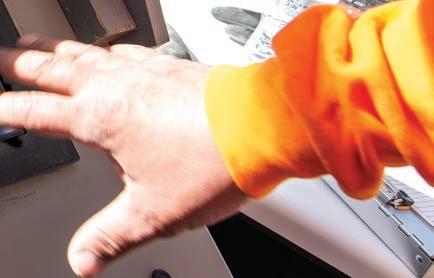

Now with FREE software!


As with most industrial control projects, cost is king, but you don’t have to sacrifice quality to keep your budget intact. For over 15 years, the C-more line has served tens of thousands of installations without missing a beat. C-more HMIs are built to last and provide many advanced capabilities, including object animations, logic and math operations, web server/mobile app access, and data logging, all for a surprisingly low price.

Orders over
Fast free standard shipping* is available for most orders over $49 U.S., and that includes the brokerage fees (when using an AutomationDirect nominated broker). Using our choice of carrier, we can reach most Canadian destinations within 2 to 3 days.
*Free shipping does not apply to items requiring LTL transport, but those shipments can take advantage of our negotiated super-low at rates (based on weight) that include brokerage fees.

See Web site for details and restrictions at: www.automationdirect.com/canada













the #1 value in automation Order Today, Ships Fast! * See our Web site for details and restrictions. © Copyright 2022 AutomationDirect, Cumming, GA USA. All rights reserved. 1-800-633-0405 Research, price, buy at: www.automationdirect.com/cmore
industry-approved HMIs
C-more Touch Panel HMIs starting at: $668.00 (EA9-T7CL-R)
HMI design software
now
free of
Get your copy now at: www.go2adc.com/cmoresw
C-more
can
be downloaded
charge. Get started on your project today or take it for a test drive. Download as often as you need. No license or key needed.
$49 get FAST FREE SHIPPING Our shipping policies make it easier than ever to order direct from the U.S.!
To see all products and prices, visit www.automationdirect.com All prices shown are U.S. Dollars




























 BY MARIO CYWINSKI
BY MARIO CYWINSKI

 Photo credit: Mario Cywinski)
Photo credit: Mario Cywinski)





























































































 Mario Cywinski is the editor of Plant magazine, MRO magazine, and Food and Beverage magazine, contact him at mcywinski@plant.ca..
Mario Cywinski is the editor of Plant magazine, MRO magazine, and Food and Beverage magazine, contact him at mcywinski@plant.ca..
























 Photo: VectorMine
/ Adobe stock
Photo: VectorMine
/ Adobe stock









































